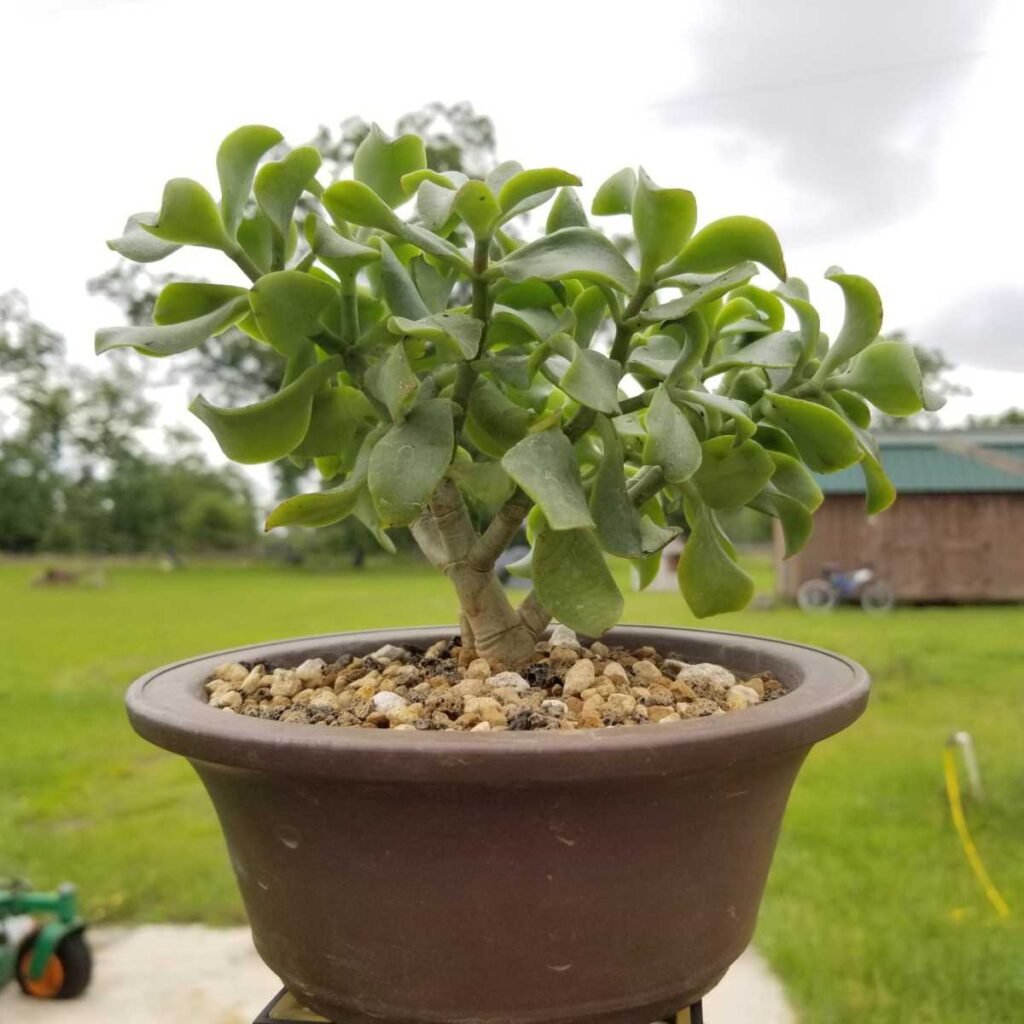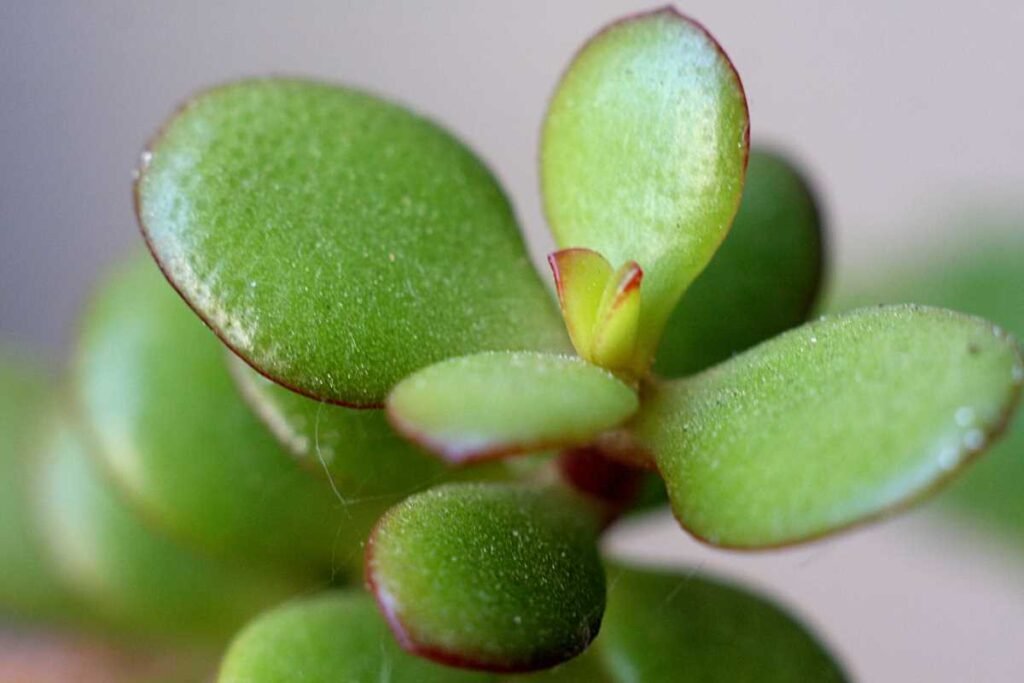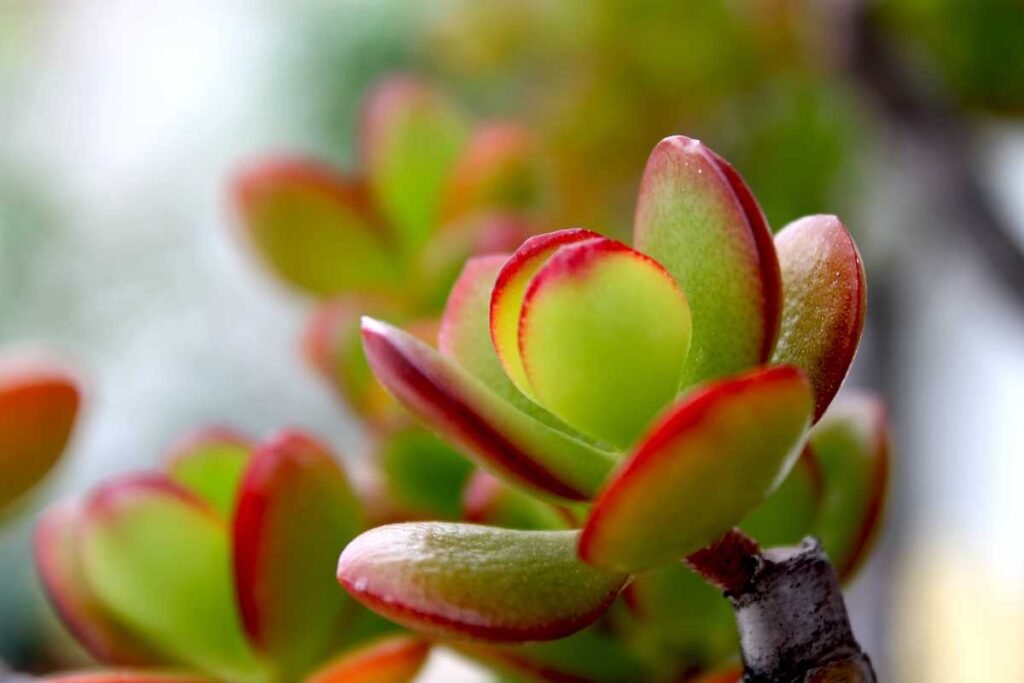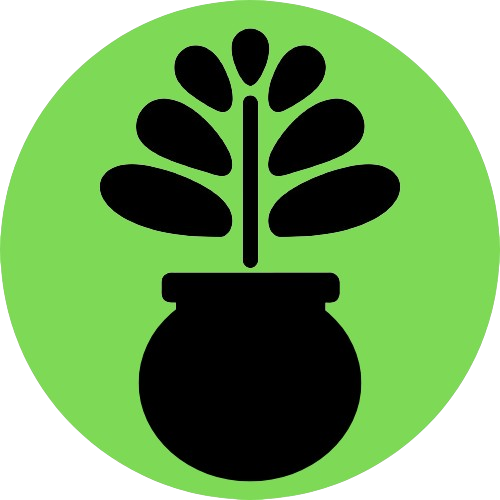Jade plants, scientifically known as Crassula ovata, are popular succulents appreciated for their thick, fleshy leaves and easy-care nature. Often associated with prosperity and good fortune, these plants are a common fixture in homes and offices worldwide. However, the world of jade plants extends beyond the well-known Crassula ovata, encompassing a variety of species and cultivars each with unique characteristics and charm. This comprehensive guide will delve into the different types of jade plants, their care requirements, and their distinctive features, providing a complete overview for enthusiasts and beginners alike.

Table of Contents
Introduction to Jade Plants
Jade plants, a prominent member of the Crassulaceae family, originate from South Africa and Mozambique. They are evergreen succulents that thrive in warm, arid conditions, making them ideal for indoor cultivation in a variety of climates. The name “jade plant” is derived from the resemblance of their leaves to jade stones, symbolizing wealth and prosperity in many cultures.
Jade plants have been cultivated for centuries, admired for their aesthetic appeal and low-maintenance nature. They are particularly valued in Feng Shui for their supposed ability to attract good luck and financial success. Whether grown as small houseplants or larger specimens, jade plants can add a touch of greenery and elegance to any space.
Care Requirements for Jade Plants
Light
Jade plants thrive in bright, indirect sunlight but can tolerate some direct sun, especially in cooler climates. Ideally, they should receive at least four to six hours of sunlight per day. In hotter regions, it’s best to provide some shade during the peak afternoon hours to prevent leaf scorching.
Watering
Being succulents, jade plants have a low water requirement. It’s crucial to allow the soil to dry out between waterings to prevent root rot. During the growing season (spring and summer), watering once every two to three weeks is typically sufficient. In the dormant winter months, watering can be reduced to once a month or less.
Soil
Jade plants prefer well-draining soil, such as a cactus or succulent mix. You can also create your own mix by combining regular potting soil with coarse sand or perlite. This helps prevent water from pooling around the roots, which can lead to rot.
Temperature
Jade plants prefer moderate temperatures between 65°F and 75°F (18°C to 24°C). They can tolerate cooler temperatures down to 50°F (10°C) but should be protected from frost, which can damage or kill the plant.
Fertilizing
A balanced, water-soluble fertilizer applied once or twice during the growing season can support healthy growth. It’s best to avoid fertilizing during the winter when the plant is dormant.
Pruning
Pruning helps maintain the desired shape and size of the plant. It also promotes bushier growth. The best time to prune is in the spring, just before the growing season begins.
Benefits of Growing Jade Plants
Aesthetic Appeal
Jade plants are known for their attractive, thick leaves and tree-like growth habit. They can be grown as small bonsai-style plants or allowed to develop into larger, more substantial specimens. Their glossy leaves and sculptural form make them a striking addition to any indoor garden.
Air Purification
Like many houseplants, jade plants can help improve indoor air quality by absorbing carbon dioxide and releasing oxygen. They can also remove toxins from the air, making your living space healthier and more pleasant.
Easy Propagation
Jade plants are easy to propagate from cuttings, making them a cost-effective option for expanding your plant collection or sharing with friends and family. With proper care, a single jade plant can produce numerous offspring over its lifetime.
Symbolic Meaning
In various cultures, jade plants are associated with prosperity, luck, and friendship. They are often given as gifts to celebrate new beginnings or to wish someone good fortune.
Common Types of Jade Plants
While the common Crassula ovata is the most recognized jade plant, there are numerous varieties and species, each with its unique attributes. Here’s an in-depth look at some of the most popular and interesting types of jade plants.
1. Crassula ovata (Common Jade Plant)

The Crassula ovata, also known as the common jade plant, is characterized by its round, fleshy, dark green leaves and thick, woody stems. This variety is what most people think of when they hear “jade plant.” It can grow up to 3 feet tall indoors and even larger outdoors in suitable climates. The common jade plant is known for its resilience and ability to thrive with minimal care.
2. Crassula ovata ‘Hummel’s Sunset’

‘Hummel’s Sunset’ is a stunning cultivar of the common jade plant. It features vibrant green leaves with yellow and red margins, giving it a sun-kissed appearance. This variety is particularly popular for its colorful foliage, which intensifies with increased sun exposure. ‘Hummel’s Sunset’ is a compact plant, typically growing to about 2 feet tall, making it ideal for small spaces.
3. Crassula ovata ‘Gollum’
The ‘Gollum’ jade plant, also known as the trumpet jade or ET’s Fingers, has a unique appearance with tubular, finger-like leaves that often have a reddish tinge. The ends of the leaves are typically puckered, resembling the suction cups of an octopus. This variety can grow up to 3 feet tall and wide, making it a fascinating addition to any succulent collection.
4. Crassula ovata ‘Hobbit’
Similar to the ‘Gollum’ jade plant, the ‘Hobbit’ variety has tubular leaves that are slightly curled at the ends. The leaves are typically green with red tips, giving the plant a striking look. ‘Hobbit’ jade plants are relatively compact, usually reaching about 2 feet in height. Their unusual leaf shape makes them a popular choice for bonsai enthusiasts.
5. Crassula ovata ‘Tricolor’
The ‘Tricolor’ jade plant is known for its variegated leaves, which display shades of green, cream, and pink. This variety is highly sought after for its colorful foliage and is often grown for its ornamental value. ‘Tricolor’ jade plants are generally smaller than other varieties, making them perfect for tabletop displays or small containers.
6. Crassula ovata ‘Crosby’s Compact’
‘Crosby’s Compact’ is a dwarf variety of the common jade plant. It features small, round leaves with a reddish hue on the edges. This compact plant grows slowly and remains relatively small, typically reaching up to 1 foot in height. Its petite size and colorful foliage make it an excellent choice for small pots and indoor gardens.
7. Crassula ovata ‘Minima’
The ‘Minima’ jade plant is a miniature variety that is perfect for small spaces and terrariums. It has tiny, round leaves that are often tinged with red at the tips. This variety is slow-growing and typically reaches a height of about 6 inches, making it ideal for windowsills and desks.
8. Crassula arborescens (Silver Jade Plant)
Crassula arborescens, commonly known as the silver jade plant or silver dollar jade, is characterized by its silver-gray leaves with reddish edges. The leaves are round and fleshy, resembling silver coins, hence the name. This variety can grow up to 4 feet tall and is known for its striking, silvery foliage.
9. Crassula perforata (String of Buttons)
The Crassula perforata, also known as the string of buttons or necklace vine, features stacked, triangular leaves that grow along a central stem, creating a string-like appearance. The leaves are typically green with red margins and form a dense, bushy plant. This variety is ideal for hanging baskets or trailing over the edges of pots.
10. Crassula rupestris (Baby’s Necklace)
The Crassula rupestris, commonly known as the baby’s necklace or rosary vine, has small, rounded leaves that are stacked along the stems like beads on a necklace. The leaves are usually green with red edges and can take on a pinkish hue in bright light. This variety is well-suited for hanging containers and makes a lovely trailing plant.
11. Crassula lactea (Taylor’s Parchment)
Crassula lactea, also known as Taylor’s parchment, has large, rounded leaves that are a pale, gray-green color. The leaves are smooth and have a slightly waxy texture. This variety is known for its sprawling growth habit and can form a dense mat of foliage. It is often used as ground cover in succulent gardens.
Other Notable Jade Plant Species
While the varieties listed above are among the most popular, there are numerous other jade plant species worth exploring. Some notable mentions include:
- Crassula capitella: Known for its bright red, triangular leaves that grow in a rosette pattern.
- Crassula falcata: Features gray-green, sickle-shaped leaves and produces striking red flowers.
- Crassula muscosa: Also known as the watch chain plant, has tiny, scale-like leaves that grow tightly along the stems, giving it a unique, textured appearance.
How to Propagate Jade Plants
Propagating jade plants is a straightforward process that can be done through leaf or stem cuttings. Here’s a step-by-step guide to propagating your jade plant:
Leaf Cuttings
- Select a Healthy Leaf: Choose a healthy, mature leaf from the jade plant.
- Remove the Leaf: Gently twist the leaf from the stem, ensuring that it comes away cleanly.
- Let it Callus: Place the leaf on a dry surface and allow it to callus over for a few days. This helps prevent rot when planted.
- Plant the Leaf: Place the callused end of the leaf into a well-draining potting mix. Water sparingly.
- Wait for Roots: Roots will start to develop in a few weeks. Keep the soil slightly moist but not waterlogged.
- Transplant: Once the new plant is established, you can transplant it into a larger pot if desired.
Stem Cuttings
- Choose a Healthy Stem: Select a healthy stem with several leaves.
- Cut the Stem: Using a clean, sharp knife or scissors, cut the stem just below a leaf node.
- Let it Callus: Allow the cut end to callus over for a few days.
- Plant the Cutting: Insert the callused end of the stem into a well-draining potting mix. Water lightly.
- Wait for Growth: New roots will start to form in a few weeks. Once the cutting is established, it can be treated as a mature plant.
Common Problems and Solutions
Overwatering
Problem: Overwatering is a common issue that can lead to root rot and other problems.
Solution: Allow the soil to dry out completely between waterings and ensure proper drainage.
Pests
Problem: Jade plants can be affected by pests such as mealybugs and spider mites.
Solution: Regularly inspect your plant and treat any infestations with insecticidal soap or neem oil.
Leaf Drop
Problem: Leaf drop can occur due to overwatering, underwatering, or sudden temperature changes.
Solution: Maintain consistent care and avoid drastic changes in the plant’s environment.
Yellowing Leaves
Problem: Yellowing leaves can be a sign of overwatering or nutrient deficiency.
Solution: Adjust your watering schedule and consider adding a balanced fertilizer during the growing season.
Related FAQs:
1. What is the most common type of jade plant?
The most common type of jade plant is Crassula ovata, also known as the common jade plant. It is widely recognized for its thick, fleshy leaves and ease of care. The common jade plant can grow quite large and is a popular choice for both indoor and outdoor gardens.
2. Are there different colors of jade plants?
Yes, jade plants come in various colors. While the typical Crassula ovata has green leaves, other varieties exhibit different hues:
- Crassula ovata ‘Hummel’s Sunset’ has green leaves with yellow and red margins.
- Crassula ovata ‘Tricolor’ features green, cream, and pink variegated leaves.
- Crassula ovata ‘Gollum’ and ‘Hobbit’ can have a reddish tinge to their tubular leaves.
- Crassula arborescens has silver-gray leaves with reddish edges.
3. What are the differences between Crassula ovata ‘Gollum’ and ‘Hobbit’?
Both ‘Gollum’ and ‘Hobbit’ are cultivars of Crassula ovata and have similar care requirements, but they have distinct leaf shapes:
- ‘Gollum’ jade has tubular, finger-like leaves with a suction-cup-like end, resembling ET’s fingers.
- ‘Hobbit’ jade has tubular leaves that are slightly curled back at the ends, giving them a different appearance compared to ‘Gollum’.
4. How can I identify a jade plant?
Identifying jade plants involves looking at the following characteristics:
- Leaf Shape: Jade plants typically have thick, fleshy leaves that can be round, oval, or tubular.
- Stem Structure: They have thick, woody stems.
- Growth Habit: Jade plants can grow upright or have a trailing habit, depending on the variety.
- Coloration: Leaf coloration can range from green to silver-gray, with some varieties having red, yellow, or cream margins.
5. Can jade plants flower?
Yes, jade plants can produce flowers, although it’s more common in mature plants and under the right conditions. Flowers are typically small, star-shaped, and white or pink. Blooming often occurs in the winter months.
6. How do I care for a jade plant with variegated leaves?
Variegated jade plants, like Crassula ovata ‘Tricolor’, require the same care as other jade plants, with a few considerations:
- Light: Ensure they receive bright, indirect sunlight to maintain their vibrant colors. Too little light can cause the variegation to fade.
- Water: Allow the soil to dry out between waterings to prevent root rot.
- Temperature: Keep them in a moderate climate and avoid frost.
7. What is a miniature jade plant?
Miniature jade plants, such as Crassula ovata ‘Minima’, are smaller varieties that grow to a modest height, usually under 6 inches. They are ideal for small spaces, terrariums, and tabletop displays due to their compact size.
8. Are there trailing jade plants?
Yes, there are jade plants with a trailing growth habit, such as:
- Crassula perforata (String of Buttons): This plant has stacked, triangular leaves and grows along a central stem.
- Crassula rupestris (Baby’s Necklace): Known for its small, rounded leaves that grow like beads along the stem, making it ideal for hanging containers.
9. How do I propagate different types of jade plants?
Jade plants can be propagated through leaf or stem cuttings:
- Leaf Cuttings: Remove a healthy leaf, allow it to callus, and then place it in well-draining soil.
- Stem Cuttings: Cut a healthy stem, let it callus, and plant it in soil. Both methods require minimal watering until new roots develop.
10. Are jade plants toxic to pets?
Yes, jade plants can be toxic to pets. If ingested, they can cause vomiting, lethargy, and incoordination in cats and dogs. It’s best to keep jade plants out of reach of pets to prevent any accidental ingestion.
11. Can jade plants be grown outdoors?
Jade plants can be grown outdoors in regions with mild, frost-free climates. They prefer full sun to partial shade and should be planted in well-draining soil. In colder climates, they should be brought indoors during the winter months to prevent frost damage.
12. What are some unique jade plant varieties?
Some unique jade plant varieties include:
- Crassula ovata ‘Hummel’s Sunset’: Known for its colorful leaves.
- Crassula arborescens (Silver Jade Plant): Has distinctive silver-gray leaves.
- Crassula perforata (String of Buttons): Features stacked, triangular leaves.
13. How do I encourage my jade plant to grow larger?
To encourage larger growth in jade plants:
- Light: Provide bright, indirect sunlight.
- Water: Water sparingly but deeply, allowing the soil to dry out between waterings.
- Fertilize: Use a balanced, water-soluble fertilizer during the growing season.
- Prune: Prune regularly to shape the plant and promote bushier growth.
14. Can jade plants be used for bonsai?
Yes, jade plants, especially varieties like Crassula ovata ‘Hobbit’ and ‘Gollum’, are popular choices for bonsai due to their tree-like structure and thick, woody stems. They are relatively easy to shape and maintain as bonsai specimens.
15. What are the benefits of having jade plants?
Jade plants offer numerous benefits, including:
- Aesthetic Appeal: Attractive, sculptural form with glossy leaves.
- Low Maintenance: Easy to care for, requiring minimal water and attention.
- Air Purification: Helps improve indoor air quality.
- Symbolic Value: Associated with prosperity and good fortune in many cultures.
16. How can I prevent pests on my jade plant?
To prevent pests like mealybugs and spider mites:
- Inspect Regularly: Check for signs of pests on the leaves and stems.
- Clean: Wipe the leaves with a damp cloth to remove dust and deter pests.
- Treat Infestations: Use insecticidal soap or neem oil if pests are detected.
17. Why are my jade plant’s leaves turning yellow?
Yellowing leaves can be a sign of overwatering or nutrient deficiency. Ensure the soil dries out between waterings and consider using a balanced fertilizer during the growing season to provide essential nutrients.
18. How can I make my jade plant more compact?
To keep your jade plant compact:
- Prune Regularly: Trim back leggy growth to encourage a bushier shape.
- Light: Provide adequate light to prevent the plant from stretching towards the light source.
- Repot: Use a smaller pot to restrict root growth, which can help maintain a compact size.
19. Are there any dwarf jade plant varieties?
Yes, dwarf varieties such as Crassula ovata ‘Crosby’s Compact’ and ‘Minima’ are popular for their small size and slow growth, making them ideal for indoor gardens and small spaces.
20. Can jade plants change color?
Jade plants can change color depending on light exposure and temperature. For example, increased sunlight can cause some varieties to develop reddish or yellowish hues at the leaf margins.
Conclusion
Jade plants are versatile, attractive succulents that can thrive with minimal care. With a variety of species and cultivars to choose from, there’s a jade plant to suit every taste and space. Whether you’re a seasoned gardener or a beginner, jade plants offer a rewarding and low-maintenance option for adding greenery to your home or office. By understanding the different types of jade plants and their care requirements, you can enjoy the beauty and benefits of these charming plants for years to come.

